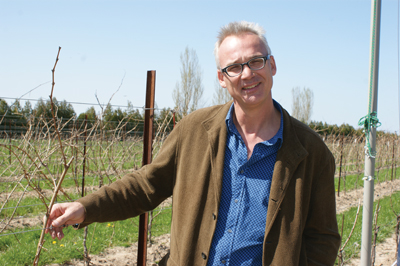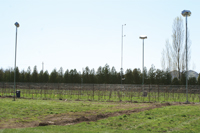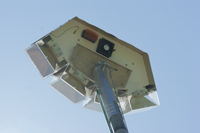
A new freezing and frost protection technology prototype has been
installed recently at the Vineland Research and Innovation Centre
(VRIC), located near Vineland, Ont.
A new freezing and frost protection technology prototype has been installed recently at the Vineland Research and Innovation Centre (VRIC), located near Vineland, Ont.
 |
| Vineland Research and Innovation Centre chief executive officer Dr. Jim Brandle hopes the Tempwave system will help save crops, including this planting of pinot noir. Photo by Margaret Land Advertisement
|
The technology, called the Tempwave™ system, was developed and installed by Raytheon Company – perhaps better known for developing technology for use by the military – within a small section of a pinot noir planting located near VRIC’s main building.

|
| The test plot of pinot noir grapes at the Vineland Research and Innovation Centre is now ringed by three Tempwave towers. Photo by Margaret Land
|
The system uses low-level microwave radiant heat to prevent frost damage to crops. The microwave energy is transmitted from tall, 25-foot-high towers located in the vineyard, changing the energy balance that slows cooling to prevent freezing damage.
“Our expertise in radio frequency technologies has the potential to redefine the way frost protection is delivered around the world,” said Larry Faria, an engineer with Raytheon’s Mission Innovation group, which has been charged with exploring and applying some of the company’s technical expertise to challenges outside of its traditional core businesses.
According to Dr. Jim Brandle, chief executive officer of VRIC, the technology works similar to a conventional microwave oven.
“It heats the moisture in the buds, causing the water molecules to vibrate,” he explained during a recent visit to the Tempwave installation. “As the molecules vibrate, the buds heat up.”
VRIC’s test plot of pinot noir grapes is now ringed by three Tempwave towers, each topped by four speaker-like boxes that direct the low-level radio waves toward the crop. In the centre of the triangle is the centre’s weather station. During testing of the system, air temperature readings will be taken plus grape buds within the plot will be wired for temperature monitoring. When the temperature dips too low, the Tempwave system will be activated to help bring bud temperatures back up. The energy is delivered directly to the crop without heating the surrounding air.
“This is not just a theory,” said Dr. Brandle, adding that the system has already been tested successfully in California citrus orchards. “We’ll see how well it works here.”
Under the terms of the contract signed by Raytheon and VRIC, Raytheon was responsible for installing the prototype system, preparing it for operation and will be supporting initial testing of the system over the next four months.
Based on Tempwave’s performance with pinot noir, Dr. Brandle hopes to extend the technology to other crops, including apricots, which are notorious for early blooming and receiving frost damage in the spring.
“We’ll figure out how to use it differently, depending on the crop,” he said. “It will add to the arsenal of wind machines, heaters, sprinklers and covers.

|
| Each of the towers is topped by four speaker-like boxes that direct low-level radio waves toward the crop. Photo by Margaret Land
|
“This new technology will save crops,” Dr. Brandle added. “Shortly, farmers will have access to an effective tool for managing their operations, no matter what the weather.”
According to Raytheon and Dr. Brandle, the technology does not depend on environmental conditions, such as temperature inversion, to work. It also does not use water, emit smoke or make any kind of noise when it’s in use.
“It can also cover smaller areas, so it has some flexibility,” said Dr. Brandle.
Tempwave is also reported to be safe for people. According to a release from VRIC, “Exposure standards for radiofrequency fields and microwaves are set to prevent health effects caused by localized or whole-body heating. Compliance with Health Canada’s ‘Limits of Human Exposure to Radiofrequency Electromagnetic Energy in the Frequency Range from 3 Khz to 300 Ghz’ during the use of Tempwave will ensure human safety.”
The technology is also not considered a radio apparatus by Industry Canada and does not require a radio licence for use.
Some funding was provided for this project through Agriculture and Agri-Food Canada and the Ontario Ministry of Agriculture, Food and Rural Affairs, via the Growing Forward program.
Print this page